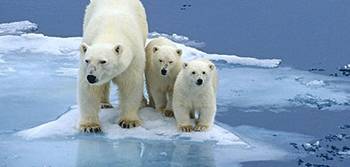
February 27, 2021 marked World Polar Bear Day. A black stone in our calendar to remind us that this magnificent mammal is threatened with extinction. This is what we have come to: organize days of remembrance that celebrate our culpable helplessness much more than the beauty of an earthly creature. So today, move around, what there is to see is not very encouraging.
Decidedly, man, in his immense stupidity, will have their skin to the last. Whether it hunts, fishes, pollutes, it will end up killing everything that moves.
As for the polar bear, the case promises to be much more delicate. Indeed, we can establish moratoriums or bans to preserve a particular species, but how to protect one of the largest terrestrial mammals from global warming? What hope should we keep in the face of the successive heat records recorded year after year in the Arctic?
We knew the polar bear was already threatened by hunting, in particular that carried out by the Inuit. 700 to 800 are killed each year for their skin, their claws or for consumption. But this has unfortunately not been the only cause for concern for some time. Indeed, the polar bear must, also, cope with the melting ice. The pack ice is disappearing and with it, its natural habitat and its means of subsistence. The thinner ice breaks up into slabs and begins to drift in the sandstone of winds and currents. On a daily basis, this translates into an increased expenditure of energy for the bear to eat and move. It has to travel much longer distances while it is physiologically constituted to use as little energy as possible. It is all the more constrained by the fact that the preys that make up its diet are also affected by climate change and therefore less abundant. Food that is becoming scarce, leads to excess mortality in cubs who do not receive milk rich enough in fat to enable them to face the harshness of the first months. This is what Steven Amstrup, one of the study's authors and chief scientist for the NGO Polar Bears International, explains to AFP, emphasizing the difficult task of the females: " They must then catch enough seals to store enough fat and produce enough milk to feed their young throughout the summer fast " . Another researcher added: " " By estimating the maximum and minimum weight of bears, and by modeling their energy expenditure, we calculated the limit number of days of fasting that a polar bear can withstand before the survival rate of adults and of the little ones begins to decline ". Needless to say, this number is down sharply.
At the top of the food chain, the polar bear feeds mainly on seals. Most of its time is spent on the pack ice, which is vital to it: it allows it to rest, to hunt, but also to reproduce. As the ice melts, the polar bear loses its bearings and is forced to take great risks to find its food, often placing it in a vulnerable position. A recent study by scientists puts forward frightening figures: 40% of sea ice could have disappeared by 2050 and the number of polar bears reduced by 30% by the same time. Beyond that, the entire Arctic marine ecosystem is endangered by the rise in temperatures.
The irony of this dramatic story is that the polar bear is dying due to the melting sea ice due to global warming, yet we now know that the melting sea ice also causes global warming. Is this vicious circle going to seal the fate of the polar bear?
And as if all this were not enough, pollution is coming to the party. If industrial inclinations do not cease for good in these regions to find there which oil, which gas, a large number of species inhabiting the ice floes will not survive. Another study indicates that the chemicals swallowed by bears render males sterile and therefore cause their populations to drop. It could therefore be that the decline of the species comes from a deficit of offspring.
Researchers argue that in the 2010s, ice melted nearly six times faster than in the 1990s, from 81 billion tonnes lost per year to 475 billion tonnes. The news is, unfortunately often, the echo of his studies. This Friday, a British research station, the British Antarctic Survey (BAS), witnessed the appearance of a fault in the Antarctic ice. A block of ice 1270 square kilometers, equivalent to the size of Paris or London, is detached from the rest of the pack ice. Who knows how far this huge iceberg will drift now? The polar bear is in bad shape and its situation will not get better. Even if he struggles desperately for his survival, that won't stop the ice from melting.
The consequence of the melting of the polar caps is the rise of a third of the sea level. Figures that would corroborate the most pessimistic scenario established by the IPCC , the Intergovernmental Panel on Climate Change . And it is not the results provided this week by the signatory countries of the Paris Agreement that will reassure us. None has achieved the objectives that have been set to effectively combat global warming. And we are far from it.
Posted on 2021-02-28 10:12









Comments